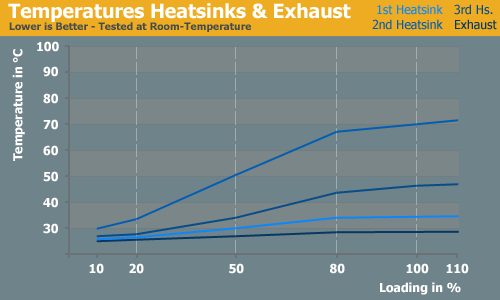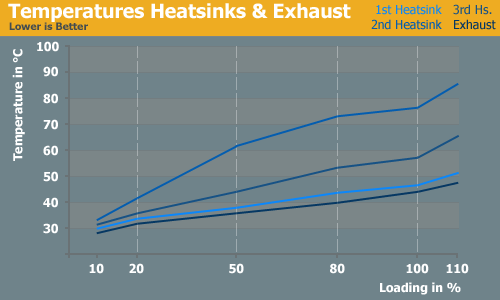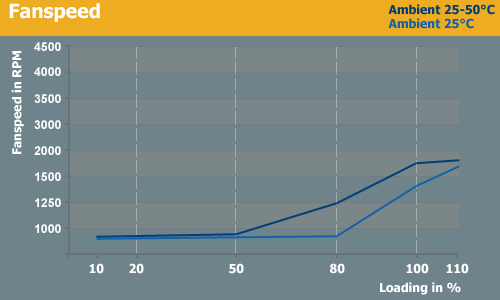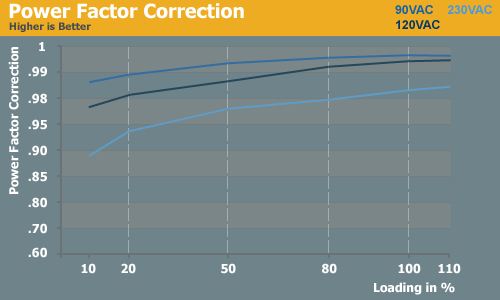400-450W PSU Roundup
by Christoph Katzer on November 6, 2007 4:00 AM EST- Posted in
- Cases/Cooling/PSUs
Corsair PFC, Temperature, Fan Speed, and Acoustics


Again, we find that the exhaust temperature is much lower than the heatsink temperatures. This indicates the heatsinks are not properly dissipating heat into the streaming air. Instead, the heat stays inside the power supply and builds up over time. While the positioning of the fan and perhaps the airflow might be to blame, the more likely problem is that the heatsinks simply aren't large enough and lack sufficient surface area. In our stress test heat chamber, we see the temperatures that are twice as high as the exhaust temperature, with the secondary heatsink reaching 85°C at the worst-case 110% load. Running a PSU under such conditions for an extended period of time would almost certainly result in a dead power supply, but it did manage to survive our short-term stress test.


Up to medium load, the power supply is extremely quiet registering less than 20dB(A). Higher loads result in increased fan speed and noise levels, and in our stress chamber we reach a maximum noise level of 28dB(A) at 80% of load (350W). However, 28dB(A) is still very quiet so in terms of noise levels users should be very pleased with Corsair. The problem is, low noise levels and low fan RPMs contribute to the relatively high heat sink temperatures. We are not sure if Corsair really tested this unit under stressful conditions - maximum load and a high ambient temperature - and we would caution users against using any of these power supplies in such an environment. Under more sedate operating conditions, however, the Corsair 450VX performs extremely well.



Again, we find that the exhaust temperature is much lower than the heatsink temperatures. This indicates the heatsinks are not properly dissipating heat into the streaming air. Instead, the heat stays inside the power supply and builds up over time. While the positioning of the fan and perhaps the airflow might be to blame, the more likely problem is that the heatsinks simply aren't large enough and lack sufficient surface area. In our stress test heat chamber, we see the temperatures that are twice as high as the exhaust temperature, with the secondary heatsink reaching 85°C at the worst-case 110% load. Running a PSU under such conditions for an extended period of time would almost certainly result in a dead power supply, but it did manage to survive our short-term stress test.


Up to medium load, the power supply is extremely quiet registering less than 20dB(A). Higher loads result in increased fan speed and noise levels, and in our stress chamber we reach a maximum noise level of 28dB(A) at 80% of load (350W). However, 28dB(A) is still very quiet so in terms of noise levels users should be very pleased with Corsair. The problem is, low noise levels and low fan RPMs contribute to the relatively high heat sink temperatures. We are not sure if Corsair really tested this unit under stressful conditions - maximum load and a high ambient temperature - and we would caution users against using any of these power supplies in such an environment. Under more sedate operating conditions, however, the Corsair 450VX performs extremely well.











37 Comments
View All Comments
Christoph Katzer - Tuesday, November 6, 2007 - link
Yup and before the use of very bulky heatsinks made the power supplies heavier. Today the components are better and the heatsinks are getting smaller again (Seasonic and FSP standard design for example).Pale Rider - Tuesday, November 6, 2007 - link
It's easily the best of the "lower" power choices.JarredWalton - Tuesday, November 6, 2007 - link
We already reviewed the Seasonic 330W and 500W, and given that Seasonic is the ODM of the Corsair and Antec units... except while Corsair is basically identical to the Seasonic model, Antec messed around with the fan to cut costs or something. 430W S12II and 450VX are pretty much the same PSU.Modular - Tuesday, November 6, 2007 - link
Page 2: "360W combined equates to 15A when both are "fully" loaded."-Should read 30A fully loaded.
Page 5: "The original design used two 17A 12V rails (as does the Earthwatts)"
-Per this review http://www.jonnyguru.com/review_details.php?id=51&...">http://www.jonnyguru.com/review_details.php?id=51&... the Earthwatts line isn't really 2 12v rails either. No biggie, but just wanted to clarify.
The Ultra is listed as a V-Series when it's actually the XVS, which is basically a step above the V-Series in that it has the flex cables and is modular.
Overall this was a pretty informative review. I'm glad that you included heat sink temps and fan noise, and it's really good to see the ripple included.
drebo - Tuesday, November 6, 2007 - link
In the retail computer sales business, I don't consider a $60 430W power supply to be a "Budget" power supply. That's more of a midrange, and is generally overkill for most of the computers sold. Even the Ultra is too expensive to bother with for most of my customers.I'd like to see a true budget roundup. Powersupplies in the $20-30 range. Like those from Athenatech or Maxtop(Q-Max) or even the lower-end Thermaltakes. I realize that they're going to be pretty crappy results, but I think it's important to see, comparitively, how they do. If it were up to me, all of my customers would be using Antec EarthWatts power supplies, but they don't understand why the extra money is necessary. With information like this, it would be far easier to convince them to spend the extra $20.
magreen - Tuesday, November 6, 2007 - link
I second that call for lower cost PSU roundups. I was under the impression that FSP makes decent enough PSUs. Can you include reviews of their 350W, 400W and 450W models? They won't have active PFC, but let's be honest, most users don't care at all about that.Iger - Tuesday, November 6, 2007 - link
+1 actually. I'd really like to understand what kind of performance can one expect from a low-end psu. Then again, Ultra probably answers the question, at least vaguely. I just wish we'd have a bigger choise of psus in europe... And better prices <sigh>Christoph Katzer - Tuesday, November 6, 2007 - link
No choice in Europe? Which country are you living in? Most shops are sending the stuff all around Europe already and you'll probably find even more in Ebay.The problem with a low end PSU roundup is that I am living in Europe as well and it will not be easy to convince a company to send me their stuff when the shipping is triple the cost of the actual product. But let us find a way and in the beginning of next year we will see what we can do...
xsilver - Wednesday, November 7, 2007 - link
Also, has it been investigated whether there are differences between varying PSU's coming off the assembly line?I would like to think that the high end manufacturers could produce identical products but Im not so sure the QC of the cheapo PSU's will give u the same PSU every time. eg. some cheap psu's seem to live on through torrid abuse and yet some just die only after 1 month of use.
Super Nade - Tuesday, November 6, 2007 - link
Hi,Why did you guys cut down on the internal component analysis? Hate to see a single picture and a few cursory words about the internal architecture. Load testing aside, I find everything else a bit boring. You had a nice thing going looking at the components, why cull it? If you decided to shorten the reviews, you could have trimmed the part about acoustics. ;)
Regards,
Super Nade
OCForums